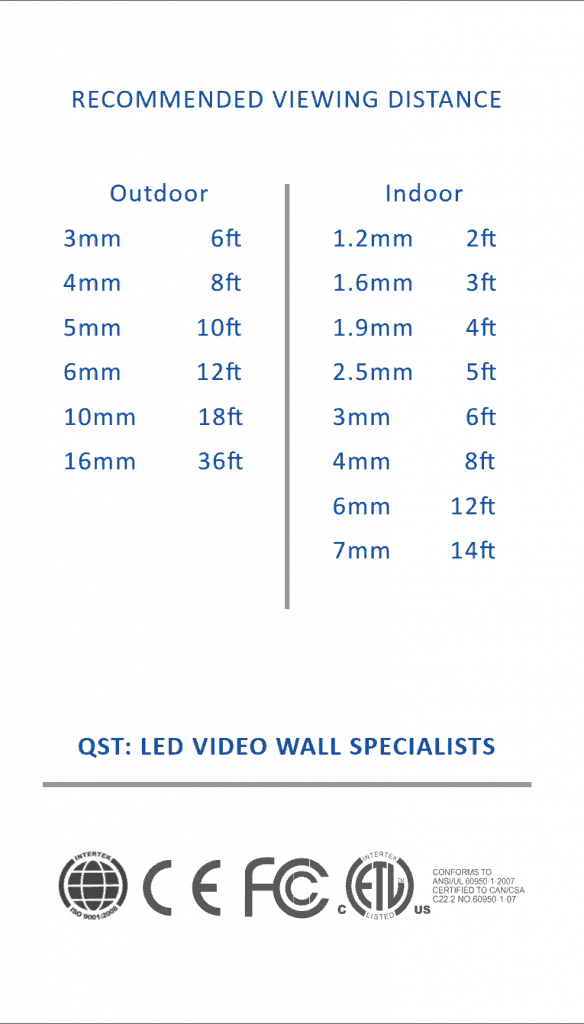Reading Time: 15 Min. | Technical Level: 5/10
It should be a primal concern for AV professionals to understand the concept of Pitch and its relationship to the following:
- Pixel Density
- Viewing Distance
- Screen Cost
- LED Package
The pitch can be referred to as the “resolution, ” but “resolution” also can refer to pixel density (number of pixels per area) or the actual pixel count (WxH) such as 1920×1080, or an established standard such as HD, 1080P, 4K, 8K etc.
Simply put, the pitch is the off-center distance between one pixel (cluster of LEDs consisting of Red, Green and Blue LEDs) to the next.
Pitch has both X and Y components, but since a majority of the LED video wall are symmetrical in X and Y pitches, it’s customary to just call out just one number.

One interesting thing to remember about pitch is the inverse relationship between it and the pixel density.
Meaning, the lower the pitch, the higher the pixel density.
As such, a 2mm has a higher pixel density and a higher resolution to 4mm.
Another mind-boggling attribute of pitch is that for every double mm decrease in pitch, the resolution actually quadruples.
This is because one must account for the 2-fold increase in both the X and Y axis.
For example, 10mm has exactly 10,000 pixels per square meter (SQM). But, a 5mm has not double but 4-fold the pixels at 40,000 pixels per SQM!
As such, one must be extra vigilant in comparing pitch off the face value!
The difference between a 3.6mm and a 2.9mm may appear to be a marginal 0.7mm, but it actually yields a 54% difference in pixel density! See below:
3.6mm: 77,000 pixels/SQM
2.9mm: 118,900 pixels/SQM
Pixelation
Notice the pixelation of the 5mm to the right vs the 1.4mm to the left. (Make sure you are viewing in 1080PHD)

Viewing Distance
Although I haven’t seen a definitive guide on this, an industry rule of thumb has always been to use 1mm per 1M of view distance.
Thus 2mm is viewed optimally at 2 meters (~6 FT), a 4mm would be optimally viewed at 4M (~12 FT) and so on.
The basis of this correlation is the concept of Convergence Distance–the distance at which the human eyes recognize an array of pixels as one coherent picture vs. multiple elements.
Before reaching the convergence distance, the viewer will perceive the image as being “pixelated.”
I suspect the exact relationship forms a geometric, but the linear explanation is the easiest to remember and use in everyday situations.
Screen Cost
As related to the above, and as one may suspect, there’s an inverse relationship between pitch and cost.
That is to say, higher the pitch, lower the pixel density and therefore lower the overall cost, and vice-versa:
The lower the pitch, the higher the pixel density and therefore higher the overall cost.
LED Package
An LED package is the type of LED encapsulation that is used to envelop the RGB dies that forms a pixel. (A die is a light-emitting wafer that emits light at a certain wavelength when a charge is run through it.)
In a previous article, we covered the difference between the two primary LED packages used in LED Screens: DIP & SMD.
The DIP package is generally at least 3mm in width and due to this size limitation, I have not seen any sub-8mm DIP screens.
SMD has stepped in to fill the void, and it has also steadily reduced in size in correspondence with the increased adoption of fine-pitch screens.
The size of SMD packages are often referred by two 2-digit numbers which correspond to the size in mm, thus an “SMD 3528” has a physical dimension of 3.5mm X 2.8mm.
In the early days, SMD 5050 and SMD 3528 were commonplace for large pitch screens, as the pitch got smaller and smaller, the packages got smaller, 2020, 1010, etc.
Indoor SMD
3528, 2020, 1010
Outdoor Rated SMD
5050, 3535, 2727, 1415
Advent of MiniLED
Nowadays, any screen under 1.9mm uses a SMD 1010 package. However, a new trend is forming with Mini and MicroLEDs.
The advent and major adoption of miniLED by LED packagers have opened up new possibilities in the upcoming years.
I will offer an in-depth analysis in later write-ups.15


